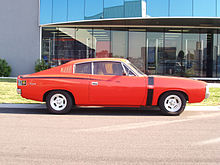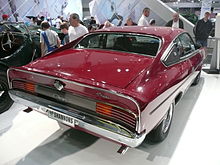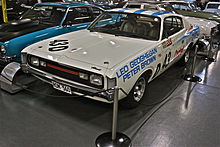- Chrysler Valiant Charger
-
Chrysler Valiant Charger 
Chrysler VH Valiant Charger R/TManufacturer Chrysler Australia Also called Chrysler Charger (VK & CL series) Production 1971–1978 Class Muscle car Body style 2-door coupe Layout FR layout Platform A-body Related Chrysler Valiant
Dodge Dart
Plymouth ValiantThe Chrysler Valiant Charger is a muscle car introduced by Chrysler Australia in 1971. It was a short wheelbase two door coupe based on the concurrent Australian Chrysler Valiant sedan. Introduced within the VH Valiant range of cars, it continued as a variant through the subsequent VJ, VK and CL series, until ceasing production in 1978.
The Charger was extraordinarily popular in Australia during the VH series and proved to be similarly so in New Zealand where they were assembled from imported kit components. The VH Valiant Charger achieved critical acclaim too, winning the 1971 Australian Wheels Car of the Year Award.
However, the very real 'muscle' persona of the Charger quickly faded through the VJ range of cars and was effectively neutered altogether by the time of the VK series release in 1975. During its seven years of production, the Charger carried many variations of essentially two basic powerplants, based around the Hemi 6 and versions of the V8 Chrysler LA engine.
Contents
VH Valiant Charger
The Chrysler VH Valiant Charger range, introduced in 1971, consisted of Charger, Charger XL, Charger 770 and Charger R/T models. The R/T (Road/Track) version effectively carried through Chrysler's performance image from the VG Valiant Pacer range, and soon became the new platform for Chrysler's continued participation in Australian touring car racing. The range of cars was broad-based with appeal to all manner of people :
Charger - 215ci base engine (140 bhp), 3spd manual, $2795.00
Charger XL - 245ci base engine (160 bhp), 3spd manual, $3195.00
Charger R/T - 265ci HP base engine (218 bhp), 3spd manual, $3395.00
Charger 770 - 265ci HP base engine (218 bhp), 3spd automatic, $3625.00
The Charger R/T and Charger 770 shared a base 265ci "HP" (high performance) 2bbl six-cylinder engine, whilst option E37 featured a tuned "Six Pack" version of the engine characterised by the fitment of triple sidedraught Weber carburettors. Exclusively available for the R/T was a further tuned version, option E38, which formed the basis of Chrysler's touring car racer for 1971. The E38 option blessed the Charger R/T with 280 bhp and bumped the base price from $3395.00 to $3975.00.
In 1972, option E49 was released for the Charger R/T, whereby a more powerful (quoted at 302 bhp) version of an E38-style engine was mated to a four speed manual gearbox. This engine produced remarkable torque on a seven bearing configuration which enabled considerable power development previously unobtained from 6-cylinder engines and not surpassed until the Porsche Turbo 911 (300) release of 1975[1]
Charger 770 SE - In August 1972 Chrysler Australia released an exclusive model based on the Charger 770. The 770 SE (Special Edition) featured an option E55 340ci 4bbl V8 engine, which many motoring journalists reported had been imported by Chrysler for an aborted racing touring car homologation exercise. Rather than release these performance 340ci engines (Chrysler LA engine)[1] as part of a Charger R/T package, Chrysler decided to tame them for a Charger 770 package via the use of a single pipe exhaust system and mandatory 'torqueflite' 727 automatic transmission. Apart from its unique engine, the Charger 770 SE featured other signature details such as combination black and white vinyl trim and a turned metal dash facia, and it was only available in three body colours, namely Vintage Red, Lime Light (green), and Sunfire (yellow metallic). Production records indicate that Chrysler manufactured a total of 125 VH Charger 770 SE cars, two of which were painted in non-standard colours.
VJ Valiant Charger
In March 1973 the VH range was superseded by the VJ series. The VJ featured changes to the cowl, grille, lighting and rear quarter feature panel,[2] with notably 7" round headlights replacing the previous rectanglular units. Significantly, this new model range saw the end of the Charger R/T, which pretty much coincided with Chrysler having officially withdrawn from participation in Australian touring car racing at the end of the 1972 season. However, the essential elements of the Six Pack E37 engine option were carried over into the VJ series, now referred to as the E48 engine option.
- option E48 - Street tune "Six Pack" 265ci engine with three two-barrel Weber carburettors and four-speed manual gearbox.
- option E55 - 4bbl 275 bhp 340ci V8 (1.88" valve heads).[2]
- option E57 - 2bbl 255 bhp 360ci V8 (introduced late 1974 to replace E55 option)
VJ Charger 770 (with option E55)
When specified with the E55 340ci V8 engine option, the VJ series cars were no longer tagged as a special edition Charger 770 "SE". This meant that a variety of colour and trim combinations are featured in E55 optioned VJ Chargers - and there is evidence of some E55 optioned Charger XL cars too - such that the only external distinguishing features were the obligatory W35 option 14x7 lightweight 5 slot 'Dragmag' alloy wheels and "340 4BBL" badges on the front guards.
There was an improvement to the motor in this model, as opposed to the previous VH model. The introduction of "Electronic Ignition" replaced the use of points ignition. This greatly improved the car for normal use making cold starts easier, and no longer requiring the ignition to be tuned every 10,000 km or so.
The Carter Thermoquad was used in this series as well, however not from the start, or at least not all the cars left the factory with one. Some still had the previous models AVS carburettor. When the carburettor change was implemented is unknown, with some examples having the Thermoquad and later builds still keeping the AVS. There is considered to be an improvement to engine performance as the flow in the carburettor was increased from 625cfm to 800cfm for the Thermoquad.
During this option's life, there were other engine variations, e.g. the motors also had a change in the cylinder heads. According to the service manuals, early VJ models maintained heads with 2.02" inlet valves, whereas later heads had a decrease in inlet valve size which saw a reduction to 1.88", again, when this was implemented is not truly known and some early build cars have the smaller valves whereas some later builds have the larger valves.
It seems that most E55 versions of the VJ Charger were manufactured during the latter half of 1973. With remaining stocks of the 340ci V8 depleted, Chrysler ceased the E55 option and in late 1974 extended availability of the lazy 360ci V8 (from the prestige Chrysler by Chrysler sedan) to the Charger 770.
VJ Charger Sportsman (option A23) : In August 1974, a limited edition Charger Sportsman was released, based upon the Charger XL. Built to a quantity of 500 units, all Sportsman cars were painted an exclusive combination of Vintage Red and white, with a combination black and white interior featuring specific cloth trim. These cars were powered by the standard 265ci engine and four speed manual transmission.
VK Charger
The mildly revised VK series Charger was released in October 1975 in only two variants [3] :
Charger XL - 3.5 litre (215ci), 3spd manual (4.0 litre and 4.3 litre engine options)
Charger 770 - 4.0 litre (245ci), 3spd manual (4.3 litre, 5.2 litre V8 and 5.9 litre V8 engine options)
The introduction of the VK series saw the demise of the "Six Pack" engine E48 option package, such that only a basic specification 4.3 litre (265ci) engine remained.
The Charger was now marketed as the Chrysler Charger rather than as the Chrysler Valiant Charger [4] with Chrysler script badging having replaced Valiant badging front and rear. Some further changes with the VK model included 'white-out' grille treatment, revised rear light clusters, and revised 'C' pillar ornamentation utilising extended fibreglass panels in black, incorporating XL or 770 badge identification. Inside, wiper and windscreen washer controls were now integrated into the indicator stalk and there were also some trim revisions that included bold Boca-Raton cloth seat inserts for the Charger 770.
In June 1976, ADR 27A (an updated emissions regulation) was implemented for all Australian market motor vehicles, which resulted in both the 3.5 litre (215ci) engine and the 5.9 litre (360ci) V8 engine being dropped from all relevant vehicles in Chrysler's VK series range.
VK Charger White Knight Special (option A50) : Following July 1976, Chrysler released 200 limited edition Charger XL cars that were principally a cosmetic treatment inside and out, and featuring a front body spoiler. Half of the production run were painted Arctic White and the other half were painted Amarante Red, with bumpers and grille painted to match. These cars featured the 4.3 litre (265ci) six-cylinder engine, with a choice of manual or automatic transmission, and interiors were trimmed to a specific combination of white vinyl with red accents.
CL Charger
The CL series Charger was introduced in late October 1976 and ultimately turned out to be the last Charger model made in Australia. This series featured new front bodywork and was expected to be designated as the VL series, but Chrysler decided to rename it CL to reflect the corporate Chrysler name which was now being applied over the whole range of cars sold in Australia.
The Charger XL variant was deleted (except for police duties) such that the CL series offered only the Charger 770 for public sale.[5]
CL Charger Drifter (A34, A49 options) : Late in the life of the CL Charger, Chrysler introduced the Drifter Pack option which was made available in four body colour choices, namely Spinnaker White (A34), Impact Orange (A49), Sundance Yellow (A49), and Harvest Gold (A49). This was basically a cosmetic option based around features found on the Chrysler Drifter panel van. These cars were available in a choice of 265ci or 318ci engines, but only with 4-speed manual transmission.
Chrysler's manufacturing production of the Charger ceased on 16 August 1978.
Motor Sport
The Valiant Charger was raced in Australia in an official capacity during 1971 and 1972, with most effort concentrated upon the annual Bathurst 500 mile touring car event. Chrysler Australia employed the services of racing driver Leo Geoghegan to assist in the development of the Charger as a touring car racer. In the 1972 Hardie-Ferodo 500 at Bathurst, a VH Charger R/T E49 driven by Doug Chivas finished the race third outright.
With the furore that erupted politically in 1972 regarding 'supercars for the streets', Australian touring car regulations changed in 1973 such that manufacturers no longer had to produce strict street versions of their racing cars. These rule changes led to principally Chrysler and then Ford abandoning official racing touring car programs in Australia.
In New Zealand, where the touring car rules were less open, the Charger proved to be virtually unbeatable from 1971 through to 1979 at the famous B&H 500 mile (later 1000 km) series held at Pukekohe Park Raceway. The most successful of New Zealand drivers were Leo Leonard and Jim Little.
References
- ^ a b Farmer, Gavin; Bridger, Gary (2003). Hey Charger : the sensational Chrysler Valiant Chargers of Australia. Auckland, New Zealand: Reed Publishing. ISBN 0790009382.
- ^ a b Davis, Tony (1987). The Valiant book : a history of Chrysler Australia's Valiant, 1962-1981. Hurstville, New South Wales: Marque Publishing Company. ISBN 0947079009.
- ^ Elisabeth Tuckey and Ewan Kennedy, Chrysler Valiant, 1996, pages 140-141
- ^ Davis, Tony (1987). Aussie cars. Hurstville, New South Wales: Marque Publishing Company. ISBN 0947079017.
- ^ Elisabeth Tuckey and Ewan Kennedy, Chrysler Valiant, 1996, page 165
Categories:- Cars of Australia
- Valiant vehicles
- Rear wheel drive vehicles
- Chrysler vehicles
- Muscle cars
Wikimedia Foundation. 2010.





